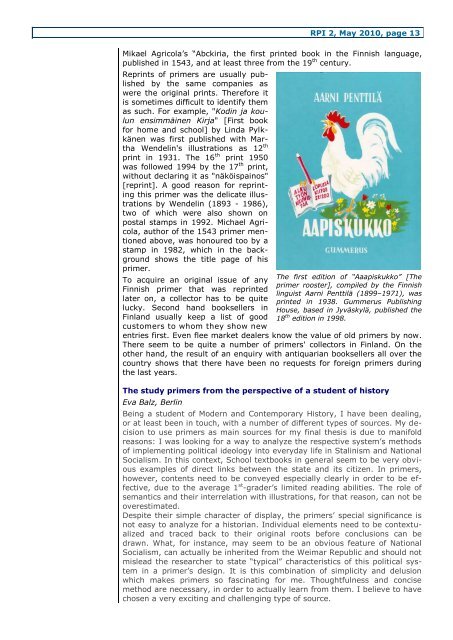- Reading Primers International No 2 S I G Newsletter 05 10
- Reading Primers International No 2 S I G Newsletter 05 10
- Reading Primers International No 2 S I G Newsletter 05 10
Create successful ePaper yourself
Turn your PDF publications into a flip-book with our unique Google optimized e-Paper software.
RPI 2, May 20<strong>10</strong>, page 13<br />
Mikael Agricola‟s “Abckiria, the first printed book in the Finnish language,<br />
published in 1543, and at least three from the 19 th century.<br />
Reprints of primers are usually published<br />
by the same companies as<br />
were the original prints. Therefore it<br />
is sometimes difficult to identify them<br />
as such. For example, "Kodin ja koulun<br />
ensimmäinen Kirja" [First book<br />
for home and school] by Linda Pylkkänen<br />
was first published with Martha<br />
Wendelin's illustrations as 12 th<br />
print in 1931. The 16 th print 1950<br />
was followed 1994 by the 17 th print,<br />
without declaring it as "näköispainos"<br />
[reprint]. A good reason for reprinting<br />
this primer was the delicate illustrations<br />
by Wendelin (1893 - 1986),<br />
two of which were also shown on<br />
postal stamps in 1992. Michael Agricola,<br />
author of the 1543 primer mentioned<br />
above, was honoured too by a<br />
stamp in 1982, which in the background<br />
shows the title page of his<br />
primer.<br />
To acquire an original issue of any<br />
Finnish primer that was reprinted<br />
later on, a collector has to be quite<br />
lucky. Second hand booksellers in<br />
Finland usually keep a list of good<br />
customers to whom they show new<br />
The first edition of “Aaapiskukko” [The<br />
primer rooster], compiled by the Finnish<br />
linguist Aarni Penttilä (1899–1971), was<br />
printed in 1938. Gummerus Publishing<br />
House, based in Jyväskylä, published the<br />
18 th edition in 1998.<br />
entries first. Even flee market dealers know the value of old primers by now.<br />
There seem to be quite a number of primers' collectors in Finland. On the<br />
other hand, the result of an enquiry with antiquarian booksellers all over the<br />
country shows that there have been no requests for foreign primers during<br />
the last years.<br />
The study primers from the perspective of a student of history<br />
Eva Balz, Berlin<br />
Being a student of Modern and Contemporary History, I have been dealing,<br />
or at least been in touch, with a number of different types of sources. My decision<br />
to use primers as main sources for my final thesis is due to manifold<br />
reasons: I was looking for a way to analyze the respective system‟s methods<br />
of implementing political ideology into everyday life in Stalinism and National<br />
Socialism. In this context, School textbooks in general seem to be very obvious<br />
examples of direct links between the state and its citizen. In primers,<br />
however, contents need to be conveyed especially clearly in order to be effective,<br />
due to the average 1 st -grader‟s limited reading abilities. The role of<br />
semantics and their interrelation with illustrations, for that reason, can not be<br />
overestimated.<br />
Despite their simple character of display, the primers‟ special significance is<br />
not easy to analyze for a historian. Individual elements need to be contextualized<br />
and traced back to their original roots before conclusions can be<br />
drawn. What, for instance, may seem to be an obvious feature of National<br />
Socialism, can actually be inherited from the Weimar Republic and should not<br />
mislead the researcher to state “typical” characteristics of this political system<br />
in a primer‟s design. It is this combination of simplicity and delusion<br />
which makes primers so fascinating for me. Thoughtfulness and concise<br />
method are necessary, in order to actually learn from them. I believe to have<br />
chosen a very exciting and challenging type of source.


